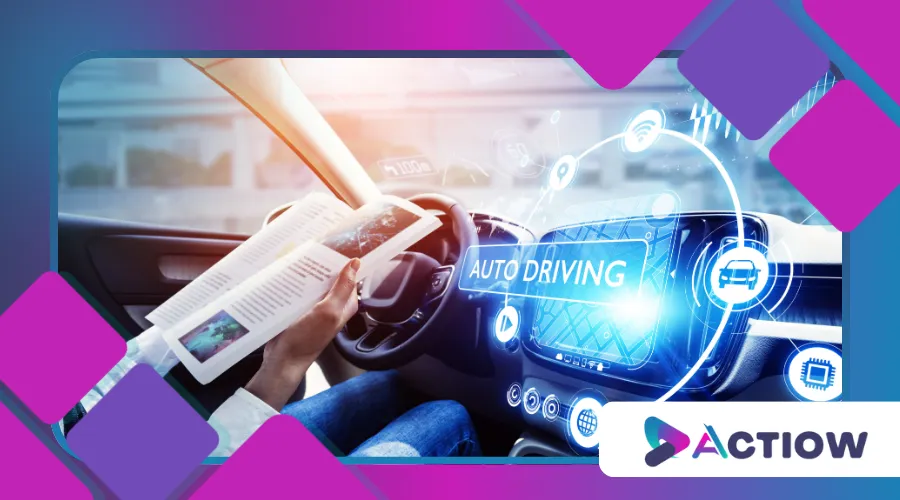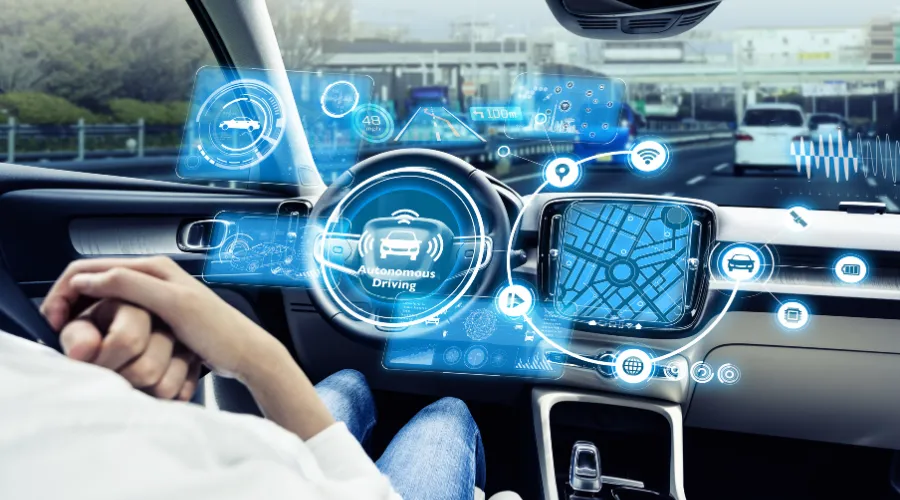Self-Driving Cars: Has the Future of Mobility Arrived?

Anúncios
The concept of self-driving cars has long been a staple of science fiction, but today, it’s closer to reality than ever before.
With companies like Tesla, Waymo, and Uber investing billions into autonomous vehicle technology, the dream of hands-free driving is no longer confined to the realm of imagination.
But has the future of mobility truly arrived, or are we still navigating the roadblocks?
Anúncios
Let’s explore the advancements, challenges, and implications of this transformative technology.
As we stand on the brink of a new era in transportation, understanding the nuances of self-driving technology becomes increasingly important.
The implications of this shift extend beyond just convenience; they touch on safety, environmental impact, and societal change.
The Rise of Autonomous Vehicles: A Technological Revolution
Autonomous vehicles are no longer a distant fantasy.
From advanced driver-assistance systems (ADAS) to fully autonomous prototypes, the automotive industry is undergoing a seismic shift.
According to a 2023 report by McKinsey, the global market for self-driving cars is projected to reach $550 billion by 2030.
This growth is fueled by advancements in artificial intelligence (AI), machine learning, and sensor technology, enabling vehicles to perceive and respond to their environment with unprecedented accuracy.
The rapid pace of innovation in this field has led to increased investment and research, pushing the boundaries of what is possible.
As companies race to develop reliable and safe autonomous systems, the competition is not only about technology but also about public perception and regulatory approval.
Levels of Autonomy: Where Are We Now?
The Society of Automotive Engineers (SAE) defines six levels of driving automation, ranging from Level 0 (no automation) to Level 5 (full automation).
Most vehicles on the road today fall under Level 2 or Level 3, offering partial automation like adaptive cruise control and lane-keeping assistance.
However, companies like Waymo and Cruise are testing Level 4 vehicles, which can operate without human intervention in specific conditions.
Understanding these levels helps consumers grasp the capabilities and limitations of current technologies.
As more vehicles incorporate advanced automation features, the transition to higher levels of autonomy may become smoother and more accepted by the public.
The Benefits of Self-Driving Cars: Why They Matter
1. Enhanced Safety
Human error accounts for approximately 94% of road accidents, according to the National Highway Traffic Safety Administration (NHTSA).
Autonomous vehicles, with their ability to process vast amounts of data in real-time, promise to reduce accidents caused by distracted or impaired driving.
By leveraging advanced sensors and algorithms, these vehicles can react faster than human drivers, potentially saving lives.
As technology continues to improve, the hope is that self-driving cars will significantly lower accident rates and enhance overall road safety.
2. Increased Accessibility
For individuals with disabilities or those unable to drive, self-driving cars could revolutionize personal mobility.
This technology has the potential to provide independence and improve quality of life for millions.
Imagine a world where elderly individuals can maintain their freedom without relying on family or caregivers for transportation.
This shift could lead to greater social inclusion and mobility for those who have historically faced barriers to independent travel.
3. Reduced Traffic Congestion
Autonomous vehicles can communicate with each other and optimize routes, potentially easing traffic congestion.
A study by the University of Illinois suggests that even a small percentage of autonomous vehicles on the road could significantly reduce traffic jams.
As these vehicles become more prevalent, we may see a transformation in how cities manage traffic flow.
Efficient routing and coordination among vehicles could lead to smoother commutes and less time spent in traffic.
4. Environmental Impact
By optimizing driving patterns and reducing idling time, autonomous vehicles could contribute to lower emissions.
Electric self-driving cars, in particular, align with global sustainability goals.
The integration of autonomous technology with electric vehicles can create a more sustainable transportation system.
As cities look to reduce their carbon footprints, the adoption of self-driving electric cars may play a critical role in achieving these objectives.

+ Electric Cars 2025: Discover the Models That Will Dominate the Roads
The Challenges: Roadblocks on the Path to Autonomy
1. Technological Limitations
While AI has made remarkable strides, it still struggles with complex driving scenarios, such as navigating construction zones or interpreting ambiguous traffic signals.
Achieving Level 5 autonomy—where a vehicle can handle all conditions without human intervention—remains a significant challenge.
As developers work to improve AI capabilities, the need for rigorous testing and validation becomes crucial.
This ongoing research aims to address the edge cases that could pose risks in real-world scenarios.
2. Regulatory Hurdles
Governments worldwide are grappling with how to regulate autonomous vehicles.
Questions about liability in the event of an accident, data privacy, and cybersecurity remain unresolved.
Without clear regulations, widespread adoption could be delayed.
As lawmakers consider the implications of self-driving technology, collaboration with industry experts will be essential to create effective policies.
3. Public Trust
A 2022 survey by AAA found that 68% of Americans are afraid to ride in a fully autonomous vehicle.
Building public trust will require extensive testing, transparency, and education about the technology’s capabilities and limitations.
Engaging with communities and addressing their concerns can foster confidence in autonomous systems.
Public awareness campaigns could play a pivotal role in demystifying self-driving technology and its safety features.
4. Ethical Dilemmas
Autonomous vehicles must be programmed to make split-second decisions in life-threatening situations.
For example, should a car prioritize the safety of its passengers or pedestrians?
These ethical questions pose significant challenges for developers and policymakers.
Establishing a framework for ethical decision-making in autonomous vehicles will be crucial as the technology progresses.
The Current State of Self-Driving Cars: Who’s Leading the Race?
Several companies are at the forefront of autonomous vehicle development:
- Tesla: Known for its Autopilot and Full Self-Driving (FSD) features, Tesla continues to push the boundaries of consumer-facing autonomy.
- Waymo: A subsidiary of Alphabet, Waymo operates a fully autonomous ride-hailing service in Phoenix, Arizona.
- Cruise: Backed by General Motors, Cruise is testing its autonomous vehicles in San Francisco.
- Uber: Despite setbacks, Uber remains committed to developing autonomous ride-sharing technology.
These companies are not only competing for market share but also setting the standards for safety and technology in the industry.
As they innovate, partnerships with tech firms and research institutions are becoming increasingly common to enhance their capabilities.
++ 10 Tips to Keep Your Car Looking New for Longer
Tables: Comparing Key Players and Technologies
| Company | Technology | Current Status |
|---|---|---|
| Tesla | Autopilot, FSD | Level 2-3 (Consumer vehicles) |
| Waymo | Fully autonomous system | Level 4 (Operational in Phoenix) |
| Cruise | Autonomous ride-hailing | Level 4 (Testing in San Francisco) |
| Uber | Self-driving ride-sharing | Level 3 (Under development) |
| Level of Autonomy | Description | Example |
|---|---|---|
| Level 2 | Partial automation (e.g., lane-keeping) | Tesla Autopilot |
| Level 3 | Conditional automation (e.g., traffic jam assist) | Audi Traffic Jam Pilot |
| Level 4 | High automation (e.g., geo-fenced autonomy) | Waymo One |
| Level 5 | Full automation (e.g., no human intervention) | Not yet commercially available |
These comparisons highlight the varying levels of progress among key players in the self-driving car industry.
As technology evolves, the competition will likely intensify, pushing all companies to innovate continuously.

The Road Ahead: What’s Next for Autonomous Vehicles?
The future of self-driving cars hinges on overcoming technological, regulatory, and societal challenges.
Key areas of focus include:
- Improving AI Capabilities: Enhancing the ability of autonomous systems to handle complex and unpredictable driving scenarios.
- Establishing Clear Regulations: Governments must create frameworks that ensure safety without stifling innovation.
- Building Public Trust: Transparent communication and rigorous testing are essential to gaining consumer confidence.
- Addressing Ethical Concerns: Developing guidelines for decision-making algorithms in critical situations.
As the industry matures, collaboration between tech companies, regulators, and the public will be vital for shaping the future landscape.
Continued dialogue will help address concerns and pave the way for broader acceptance of autonomous vehicles.
The Economic and Social Impact of Self-Driving Cars
The widespread adoption of autonomous vehicles could have far-reaching implications:
- Job Displacement: While self-driving cars could create new jobs in tech and maintenance, they may also displace millions of drivers in industries like trucking and ride-sharing.
- Urban Planning: Cities may need to redesign infrastructure to accommodate autonomous vehicles, such as dedicated lanes or smart traffic systems.
- Environmental Benefits: If integrated with electric vehicle technology, autonomous cars could play a key role in reducing greenhouse gas emissions.
As we consider these impacts, it’s essential to weigh the benefits against potential challenges.
Policymakers will need to address job transitions and urban planning to ensure a smooth integration of self-driving technology into society.
Conclusion: Has the Future Arrived?
The journey toward fully autonomous vehicles is well underway, but the destination remains uncertain.
While self-driving cars offer immense potential to transform mobility, significant hurdles must be overcome before they become a mainstream reality.
The technology is advancing rapidly, but questions about safety, regulation, and public acceptance linger.
For now, the future of mobility is a work in progress.
Whether you’re an enthusiast eagerly awaiting the next breakthrough or a skeptic concerned about the risks, one thing is clear: the road ahead is anything but predictable.
As we navigate this exciting yet uncertain terrain, one question remains—are we ready to let go of the wheel?
For more insights into the future of transportation, visit Autonomous Vehicles: The Future of Mobility.
By examining the advancements, benefits, and challenges of self-driving cars, this article aims to provide a comprehensive overview of where we stand today and what the future may hold.
Whether you’re a tech enthusiast, a policymaker, or simply a curious reader, the evolution of autonomous vehicles is a story worth following.
Buckle up—the ride is just beginning.
